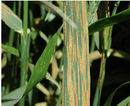Annual Review of Phytopathology (2016) 54, 207-228
From Pestinfo-Wiki
 | Selected publication you are invited to contribute to the discussion section (above tab) |
Role of alternate hosts in epidemiology and pathogen variation of cereal rusts
Annual Review of Phytopathology 54, 207-228
Abstract: Cereal rusts, caused by obligate and biotrophic fungi in the genus Puccinia, are important diseases that threaten world food security. With the recent discovery of alternate hosts for the stripe rust fungus (Puccinia striiformis), all cereal rust fungi are now known to be heteroecious, requiring two distinct plant species serving as primary or alternate hosts to complete their sexual life cycle. The roles of the alternate hosts in disease epidemiology and pathogen variation vary greatly from species to species and from region to region because of different climatic and cropping conditions. We focus this review on rust fungi of small grains, mainly stripe rust, stem rust, leaf rust, and crown rust of wheat, barley, oat, rye, and triticale, with emphases on the contributions of alternate hosts to the development and management of rust diseases.
(The abstract is excluded from the Creative Commons licence and has been copied with permission by the publisher.)
Link to article at publishers website
Database assignments for author(s): Xianming Chen, Zhen Sheng Kang
Research topic(s) for pests/diseases/weeds:
population dynamics/ epidemiology
general biology - morphology - evolution
Pest and/or beneficial records:
| Beneficial | Pest/Disease/Weed | Crop/Product | Country | Quarant. |
|---|---|---|---|---|
| Puccinia striiformis |